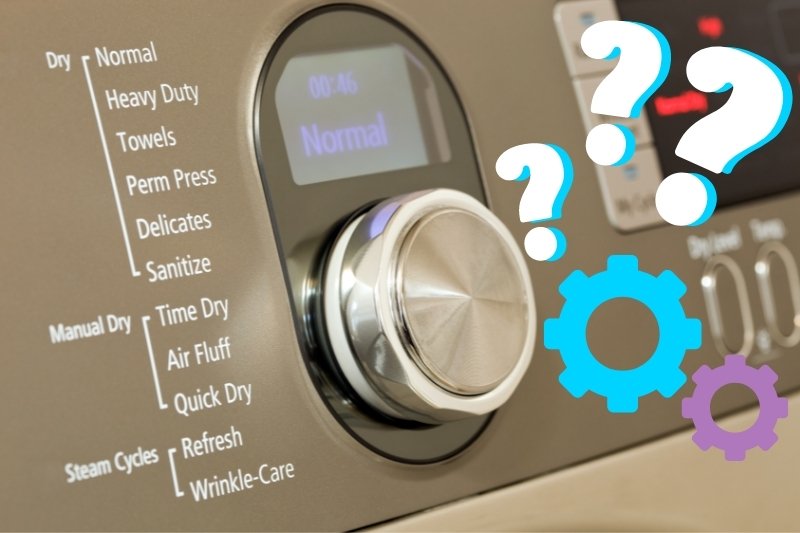If you’re new to the tumble dryer scene you may be a little confused by all the buttons, and/or dials you have on the front of your machine.
Sometimes manufacturers put little icons next to words to help you figure out what each setting means, but this isn’t always the case.
Lucky for you I’m here to explain what each tumble dryer setting means for you! Keep on reading to find out what button you should use and when.
So, one of the first things you should always do when you buy any new appliance is to read your user handbook. This usually comes with the tumble dryer when it’s delivered, but if you can’t find it you can hop onto the manufacturer’s website and download a PDF from there.
Once you’ve got hold of a copy of your user handbook, you’ll be told what each setting means, and usually you get a little description of what items would work on that setting.
Of course, it’s not going to be ideal for everyone, because everyone dries different items in their tumble dryers, and not everyone wants to read the handbook – so join me as I go into more detail about the settings on your tumble dryer!
Note: Each setting’s drying time varies from one tumble dryer to another. It is better to test out a setting and time it yourself to get an accurate time stamp.
In addition to this, each cycle temperature will also vary from manufacturer to manufacturer. It is always worth reading your user handbook or the manufacturer’s website to find out these details.
Child Lock
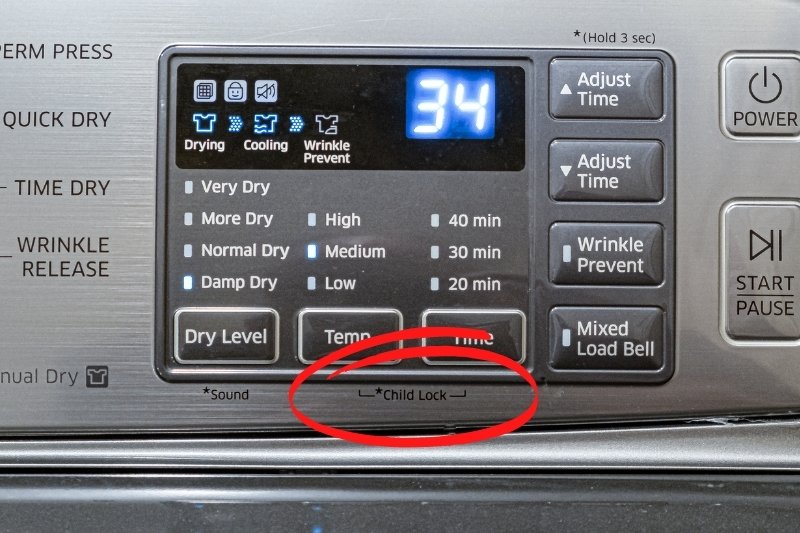
Some, but not all, tumble dryers come with a ‘child lock’ setting that you can activate when you’re drying items of clothing.
This setting locks the door and stops it from opening mid-cycle. It’s a really handy little button that you can press if you’ve got a busy home, or if you’ve got kids that like to play with gadgets around the house.
Anti-Crease
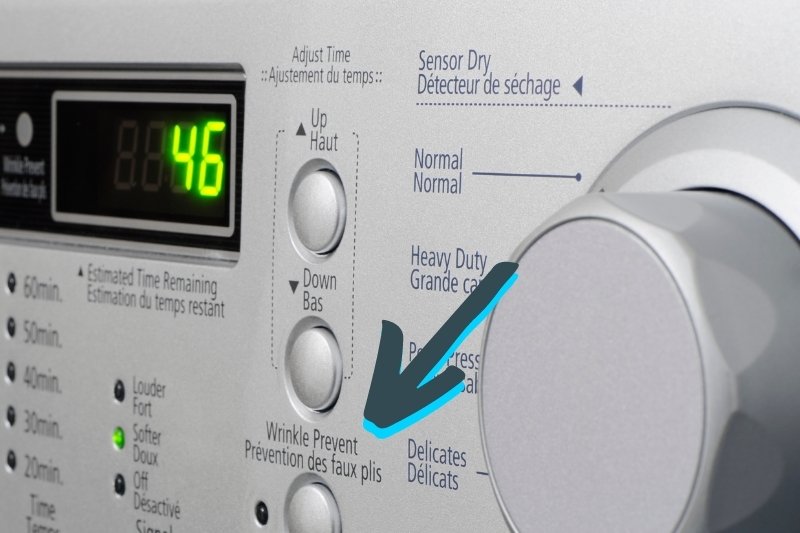
The ‘anti-crease’ setting can be used to prevent items that have already been dried in the dryer from getting creased up. Selecting this setting means that the dryer will agitate the clothes on and off again after the drying cycle has ended. It’s helpful for those of you who forget to pull your clothes out of the machine.
Timed Dry
A ‘timed dry’ setting is when you pick how long you want your clothes dried for. You could, for example, choose between 15 minutes to 90 minutes of drying time. Once you’ve selected a time, either by pressing a button on the machine or turning the dial, your tumble dryer will start and run a cycle for the length of time you’ve selected.
This setting isn’t necessarily designed with delicate clothes in mind, so if you have clothes that are likely to be ruined with too much heat, it is better to avoid using such a setting.
Cotton Settings
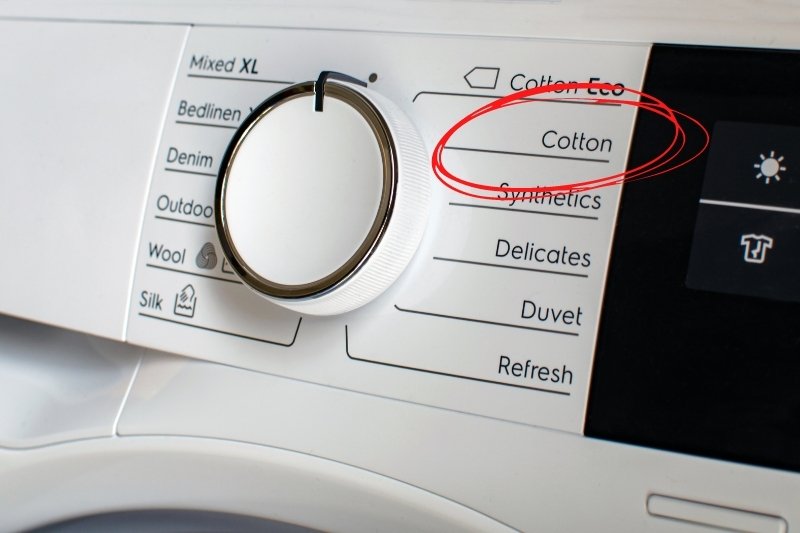
If you have a setting section labelled ‘cotton settings’ on your tumble dryer, then these settings apply to cotton clothes and items only. These settings make the tumble dryer very hot and this isn’t a suitable temperature for delicate materials.
Under such setting you may find the following options (there may be some name variation):
- ‘Ready to wear’ – This setting means that you can pop cotton clothes into the machine, choose this setting, and when the cycle has ended the clothes will be ready to wear.
- ‘Standard cotton’ – This setting would be suitable for heavy duty cotton items, for example, bed sheets.
- ‘Easy iron’ – This setting is typically used to cool down clothes that have been recently tumble dried on a hot temperature. The cooling off period allows the clothing’s fibres to relax again, and so they’re easier to iron later on.
Delicate Settings
Delicate settings are better used on delicate materials. Cycles run on this setting are typically of a much lower temperature, but this does mean that cycles take a little longer than usual to complete.
In addition to this, you should only ever put half a load of delicate laundry in to dry at once when using these settings.
For example, if you have a 9 kg tumble dryer, when you select a ‘delicates’ setting you should only fill the dryer up to 4.5 kg.
Under such settings you may find the following options (there may be some name variations, for example ‘easy care’):
- ‘Synthetics’ – This setting is designed for general synthetic based items, like clothes made from polyester. The low temperature inside the machine is designed to prevent harm from coming to the fibres in the delicate material.
- ‘Synthetics easy iron’ – This setting dries clothes in the same way as the ‘synthetics’ setting, but before the cycle ends, a cool cycle is run to make sure that the clothes come out and are ready to be ironed.
- ‘Silk’ – Some tumble dryers, but not all, will have a ‘silk’ setting which can be used to dry silk clothing. While it’s usually not advised to dry silk items in a tumble dryer, if you really must do so, you should pick the ‘silk’ option because this will ensure an extremely low temperature will be used to dry the item.
However, if you have the option and the time, air drying is the go-to option when silks are involved as this will prevent too many wrinkles from forming in the material.
Exclusive Care Settings
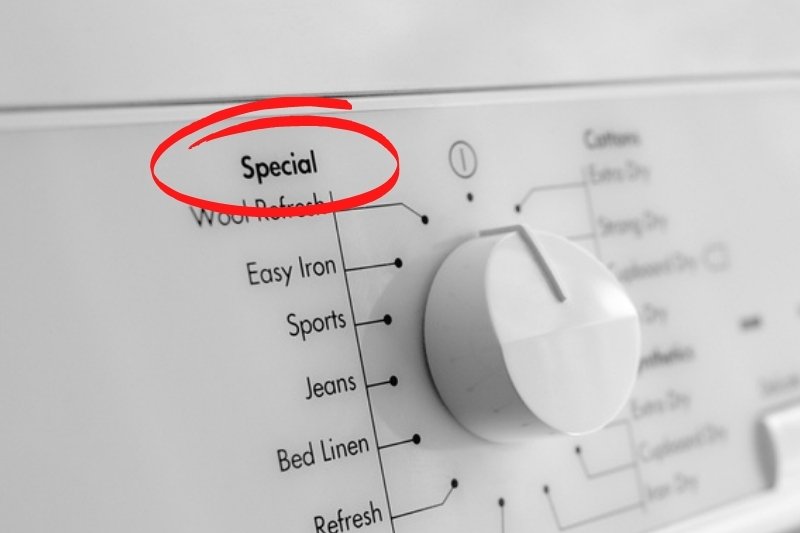
Every tumble dryer will have their own version of these settings, below you’ll find the most popular options.
- ‘Anti Allergy’ – This setting is the one to choose if you, or someone in your home has sensitive skin. This setting dries clothes as normal, but at the same time the machine works hard to remove excess dust particles, pollen and anything else that can cause irritation and allergies to flare up.
- ‘Shirts’ – This setting allows shirts to be dried in the tumble dryer, but on a low heat setting, which is ideal for the material. That being said, not all shirts can be tumble dried, so you should always check the care labels on your clothing before continuing with this method.
- ‘Jeans’ – Jeans need to be dried inside out and on a low heat setting. By choosing the ‘jeans’ setting on your tumble dryer you’ll effectively prevent your jeans from shrinking, from becoming damaged, and from losing colour.
Additionally, some people like to throw in some dryer balls to aid the drying process. The balls move around inside the machine and help to agitate the jeans, help warm air to circulate better and can even limit the number of wrinkles that form.
Although, it’s not uncommon to hear people saying that air-drying jeans is the best way to dry them. So, if this is an option you could try this out too.
‘Baby cycle’ – The ‘baby cycle’ setting can be used to dry delicate baby clothes, although you shouldn’t dry any items that contain plastic in the tumble (bibs, for example). Once this cycle has finished most items are usually dry and can be worn immediately.
But sometimes, some heavier items are still a little wet, so you’d need to turn them inside out and dry them again on the same setting.
Sportswear
Sportswear is usually made up of a lot of stretchy material that doesn’t really react well with intense temperatures. So, if your only option is to tumble dry these items, be sure to pick the ‘sportswear’ setting.
Choosing the ‘sportswear’ setting means that your items won’t be exposed to too much heat, and although they may take longer to dry, they are less likely to be damaged. Other settings like the cotton ones would ruin these items of clothing.
Alarm
You may have a setting on your tumble dryer that allows you to set an alarm to alert you when the tumble dryer is finished. Not every dryer has one of these, so if you can’t find this button don’t worry too much.
Refresh
The ‘refresh’ setting allows you to quickly spruce up clothes that have been sitting in the tumble dryer for a period of time. The cycle isn’t usually a long one as it’s designed to quickly ‘refresh’ your already dried clothes.
This setting is useful if you just need to warm up your clothes, to agitate your clothes once more before removing them from the machine, or to remove any stale odours.
Delay Timer
The ‘delay timer’ setting allows you to start the tumble dryer at a later time.
Cupboard Dry
This setting can be called various names, for example, ‘ready to wear’, and different manufacturers have varied definitions about what this setting actually means.
In general, if you choose this setting your clothes, for example, will come out of the dryer and you’ll be able to store them/wear them straight away.
It’s not always clear what heat setting clothes in this cycle will be dried on, so it isn’t likely to be suitable for delicate materials that are likely to be damaged, or wrinkled up, when they’re exposed to extreme heat.
Extra Dry
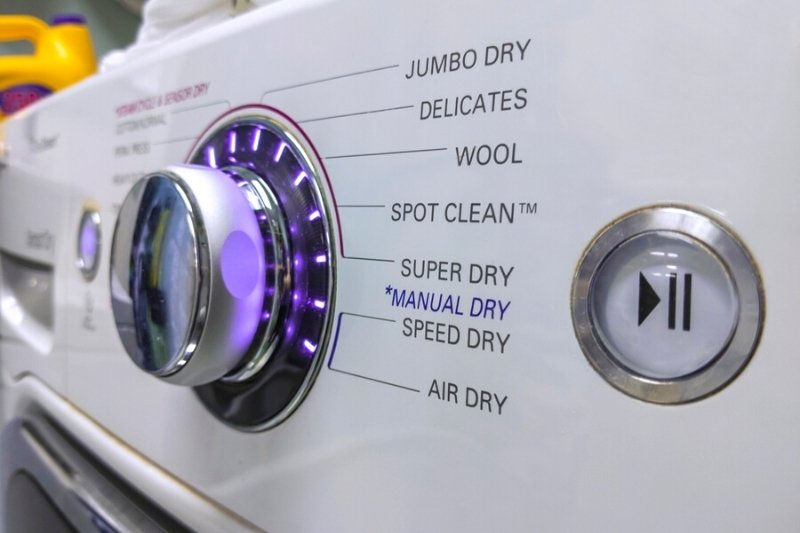
An ‘extra dry’ setting is most suitable for heavy cotton items that need that little bit of extra drying time (bedding and towels, for example). These cycles are likely to be quite long and hot.
Low Heat
Some dryers, but not all, come with a setting that allows you to choose a ‘low heat’ cycle. As the name suggests, if you choose this setting your dryer will run a very low heat cycle to dry your clothes. This setting is very useful for delicate clothes, and for items that should not be dried at high temperatures.
This setting may not be useful for heavy cotton items that actually need a lot of heat to dry effectively. Cotton items dried on such a setting are likely to take an age to dry too.
High Heat
‘High heat’ cycles are suitable for cotton clothes/items that are able to deal with high temperatures. This setting is not suitable for delicate materials, like synthetics and silk.

Bethan has a passion for exploring, reading, cooking and gardening! When she’s not creating culinary delights for her family, she’s concocting potions to keep her house clean!
